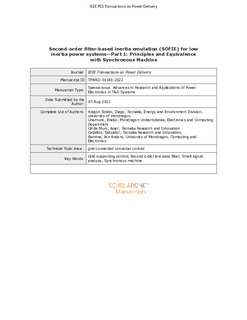
Izenburua
Second-order Filter-based Inertia Emulation (SOFIE) for Low Inertia Power SystemsArgitalpen data
2024Argitaratzailea
IEEEGako-hitzak
Low-pass filters
Power system stability
Sistemas electrónicos de potencia aplicados al control de la energía eléctrica
ODS 7 Energía asequible y no contaminante ... [+]
Power system stability
Sistemas electrónicos de potencia aplicados al control de la energía eléctrica
ODS 7 Energía asequible y no contaminante ... [+]
Low-pass filters
Power system stability
Sistemas electrónicos de potencia aplicados al control de la energía eléctrica
ODS 7 Energía asequible y no contaminante
Phase locked loops
Power system dynamics
Emulation
Synchronous machines
Frequency control [-]
Power system stability
Sistemas electrónicos de potencia aplicados al control de la energía eléctrica
ODS 7 Energía asequible y no contaminante
Phase locked loops
Power system dynamics
Emulation
Synchronous machines
Frequency control [-]
Laburpena
The massive integration of power electronic converters into the power grid has led to a decrease in the mechanical inertia of power systems, causing an increase in the rate of change of frequency (RoC ... [+]
The massive integration of power electronic converters into the power grid has led to a decrease in the mechanical inertia of power systems, causing an increase in the rate of change of frequency (RoCoF) that may lead to stability problems. The scientific community has focused on developing grid-forming control techniques, although their implementation implies a significant change in the firmware of the converter. Grid-supporting approaches, on the other hand, are an interesting alternative to add frequency support to the grid while preserving the original control structure of the converter. This article proposes three new grid-supporting control techniques based on the dynamic behaviour of a synchronous machine (SM) and its equivalence with a second-order low-pass filter. They endow the converter with the capability of providing synthetic inertia, damping, droop-based p/f primary response and virtual reactance. The dynamics of the proposed implementations are compared with a reduced-order synchronous machine by means of time-domain simulations and in-depth state-space-based small signal analyses. Besides, their operation is validated in a nine-bus low-inertia power system. Hardware-in-the-loop (HIL) laboratory results are used to validate experimentally the proposed techniques. [-]




















